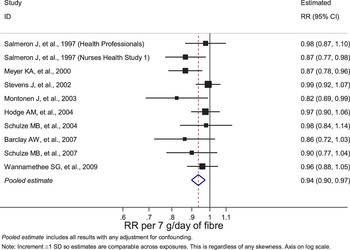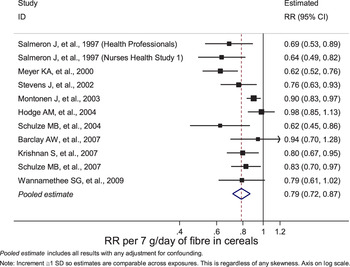Type 2 Diabetes Mellitus remains a social and economic burden in Europe and elsewhere as rates continue to rise annually( Reference Passa 1 ). Potential mechanisms exist for the action of dietary fibre on diabetes risk, such as the attenuation in postprandial glucose rise with greater intake of soluble fibre( Reference Weickert and Pfeiffer 2 ). Long-term epidemiological data help to explore such associations and a systematic review and meta-analysis was therefore undertaken to synthesize findings from prospective studies published between January 1990 and November 2009. Medline and several other databases were searched for prospective studies reporting a minimum of three years of follow-up.
Eleven studies conducted in Finland, the USA, Australia, Germany and the UK were included in dose response, random-effects meta-analyses to explore associations between incident type 2 diabetes and intakes of total dietary fibre, insoluble and soluble fibre and main sources of fibre (cereal, fruit, vegetable). The summary relative risk (RR) for 10 studies reporting total fibre intake and diabetes risk was 0.94 (95% Confidence Interval (CI) 0.90 to 0.97) for each 7 g/day increase in fibre (Fig. 1). There was little heterogeneity between the studies (I2=19%). Using data from 11 studies, fibre from cereals was associated with reduced diabetes risk. For every 7 g/day consumed, risk was 0.79 (95% CI 0.72 to 0.87) (Fig. 2), however, there was considerable heterogeneity between studies (I2=65%). Both insoluble and soluble fibre were separately associated with risk reduction but no associations were observed when studies reporting fibre from fruits (RR per 4 g/day 0.99; 95% CI 0.95 to 1.04) or from vegetables (RR per 4 g/day 0.99; 95% CI 0.94 to 1.04) were separately examined.

Fig. 1. Risk of incident diabetes mellitus type 2 per 7 g/day increase in total fibre intake.

Fig. 2. Risk of incident diabetes mellitus type 2 per 7 g/day increase in cereal fibre intake.
With 6% reduction in diabetes risk for each 7 g/day increase in total fibre consumed (equivalent to one standard deviation in UK intake), findings support national recommendations to increase dietary fibre intake. These analyses indicate both soluble and insoluble types of fibre and especially fibre from cereal sources may also aid in preventing development of type 2 diabetes mellitus.
This work was funded by the Department of Health for England.




